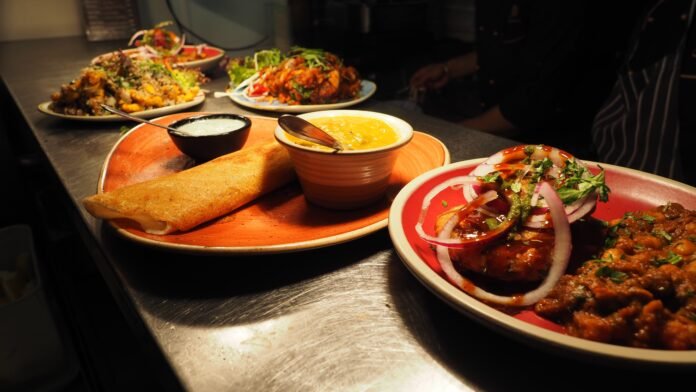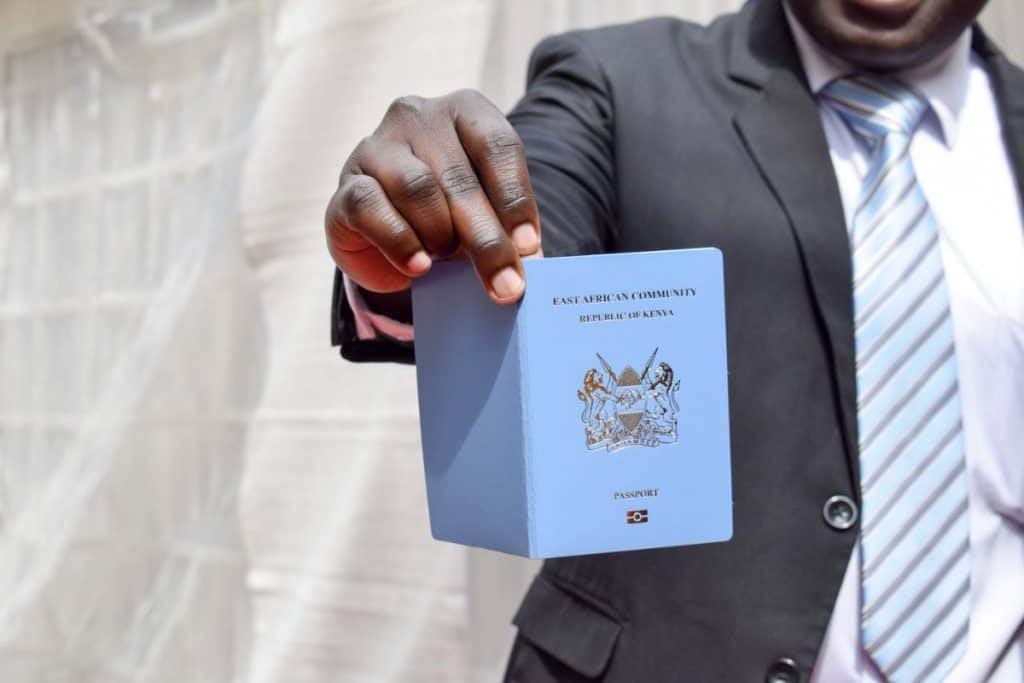Traveling across Africa takes you through heaps of street foods to sample. Typically, African street food is incredibly diverse, and you can find a wide range of delicious options in markets across the continent.
Here are some top street foods, their average prices (which can vary depending on location and vendor), how they are made, what’s unique about them, and how they are typically served:
Suya (Nigeria):
Average Price: 200-500 NGN (Nigerian Naira) per skewer.
Preparation: Skewered and grilled meat, typically beef, chicken, or goat, marinated in a spicy peanut sauce.
Unique Feature: The flavorful spice mix and nutty sauce.
Serving: Served on skewers, garnished with onions and tomatoes.
Dibi (Senegal):
Average Price: Varies but is generally affordable.
Preparation: Grilled lamb or goat marinated in herbs and spices.
Unique Feature: The meat is often cooked over an open flame.
Serving: Served with mustard sauce and bread.
Akara (Nigeria):
Average Price: About 20-50 NGN per piece.
Preparation: Deep-fried bean cakes made from black-eyed peas and spices.
Unique Feature: Crispy on the outside and soft on the inside. It is often served with spicy pepper sauce.
Bunny Chow (South Africa):
Average Price: Prices vary but are generally affordable.
Preparation: Hollowed-out loaf of bread filled with curry, typically vegetarian or with meat.
Unique Feature: The bread serves as both a container and an accompaniment.
Serving: Served with sambal or pickles.
Pofaki (Morocco):
Average Price: Around 5-15 MAD (Moroccan Dirham) for a portion.
Preparation: Fried chicken gizzards coated in spices and herbs.
Unique Feature: A popular Moroccan street snack.
Serving: Often served with spicy harissa sauce.
Roosterkoek (South Africa):
Average Price: Approximately 10-25 ZAR (South African Rand) per roll.
Preparation: Grilled bread rolls, often served with various fillings.
Unique Feature: A South African twist on grilled sandwiches.
Serving: Filled with options like boerewors (sausage) or cheese.
Taho (Philippines & West Africa):
Average Price: Prices vary depending on location.
Preparation: Silken tofu topped with arnibal (caramelized brown sugar) and sago pearls (similar to tapioca pearls).
Unique Feature: A sweet and comforting snack.
Serving: Typically served in a cup or bowl.
Chinchinga (Ghana):
Average Price: Around 2-5 GHS (Ghanaian Cedi) per skewer.
Preparation: Skewered and grilled meat, often beef or chicken, marinated in spices.
Unique Feature: Ghana’s version of kebabs.
Serving: Served on skewers, often with spicy sauces.
Boerewors (South Africa):
Average Price: About 30-60 ZAR per 100 grams.
Preparation: A flavorful, spiral-shaped sausage made from a blend of meats and spices.
Unique Feature: Known for its distinctive flavor and shape.
Serving: Grilled and often served in a roll with condiments.
Malva Pudding (South Africa):
Average Price: Varies but is typically affordable.
Preparation: A warm and sticky South African dessert made with apricot jam.
Unique Feature: Sweet and comforting.
Serving: Served as a dessert, often with custard or ice cream.
Maandazi (East Africa):
Average Price: Around 10-20 KES (Kenyan Shilling) per piece.
Preparation: Deep-fried sweet dough, similar to doughnuts.
Unique Feature: Variations include coconut or cardamom flavors.
Serving: Served as a snack or dessert.
Moi Moi (Nigeria):
Average Price: About 50-100 NGN per serving.
Preparation: A steamed bean pudding made from grounded peeled beans and spices.
Unique Feature: High in protein and nutrients.
Serving: Often served with stew, rice, or as a side dish.
Fataya (Senegal):
Average Price: Varies but is usually affordable.
Preparation: A popular Senegalese pastry filled with meat, vegetables, and spices.
Unique Feature: Similar to a meat pie or turnover.
Serving: Served as a savory snack or meal.
Kelewele (Ghana):
Average Price: A portion can range from 2-5 GHS.
Preparation: Spicy, fried plantains, typically served as a side or snack.
Unique Feature: Plantains are seasoned with ginger, chili, and other spices.
Serving: Often served with peanuts or as an accompaniment.
Samosa/Sambusa (Kenya/Somalia):
Average Price: Prices vary but are generally affordable.
Preparation: Prepared dough pockets are filled with a mixture of meat, vegetables, and spices.
Unique Feature: Variations include ground beef or spiced potatoes.
Serving: Served with chutneys or sauces for dipping.
Ugali (Kenya):
Average Price: Typically, inexpensive.
Preparation: A stiff maize porridge made from cornmeal and water.
Unique Feature: A staple food in many African countries.
Serving: Often served with a variety of stews or sauces.
Vitumbua (East Africa):
Average Price: About 10-30 TZS (Tanzanian Shilling) for a portion.
Preparation: Small, fried rice flour cakes with coconut milk and cardamom.
Unique Feature: Sweet and aromatic
Serving: Typically served as a dessert or snack.
Koshari (Egypt):
Average Price: Around 10-20 EGP (Egyptian Pound) per serving.
Preparation: A layered dish of rice, pasta, lentils, and sauces.
Unique Feature: A fusion of Middle Eastern and Mediterranean flavors.
Serving: Often served in a bowl with a drizzle of sauce.
Tamales (North Africa):
Average Price: Varies depending on the filling and location.
Preparation: Corn masa dough filled with meats, vegetables, and spices, wrapped in corn husks.
Unique Feature: A popular street food with various regional variations.
Serving: Typically served as a handheld snack.
Biltong (South Africa):
Average Price: Varies, but it’s generally affordable.
Preparation: Air-dried, cured meat, often beef or game meats.
Unique Feature: Similar to beef jerky but with a distinct flavor.
Serving: Served as a dried meat snack.
Katogo (Uganda):
Average Price: The price can vary, but it is generally an affordable dish.
Preparation: Katogo is a Ugandan stew made with a combination of ingredients, which can include meat, vegetables, plantains, groundnut sauce, and other seasonings. The ingredients are simmered together to create a flavorful one-pot dish.
Unique Feature: The unique aspect of Katogo is its versatility. It can be made with different combinations of ingredients, allowing for a wide range of flavors and variations.
Serving: Katogo is typically served in a bowl or on a plate and is often eaten with a side of steamed rice, posho (a type of maize porridge), or boiled cassava.
Nyama Choma (East Africa, especially Kenya):
Average Price: The cost varies based on the type and quantity of meat and the location, but it is generally affordable.
Preparation: Nyama Choma translates to “grilled meat.” It involves skewering and grilling meat, often beef or goat, over an open flame. The meat is usually marinated with spices and herbs before grilling.
Unique Feature: Nyama Choma is known for its smoky flavor and is a popular dish for gatherings and social events in East Africa.
Serving: Nyama Choma is often served with a side of vegetables, ugali (a stiff maize porridge), and spicy sauces or condiments. It’s a communal dish meant to be shared.
Kaunga (East and Southern Africa):
Average Price: Kaunga is typically an inexpensive staple food.
Preparation: Kaunga, also known as Ugali, sima or sadza in other African countries, is a stiff porridge made from maize meal and water. The maize meal is slowly cooked and stirred until it reaches a thick, dough-like consistency.
Unique Feature: Kaunga is a common and filling accompaniment to various Kenyan dishes. It serves as a staple carbohydrate in Kenyan cuisine.
Serving: Kaunga is typically served as a side dish alongside stews, soups, or sauces. It is often used as a base for other dishes to soak up the flavors.
Fufu (West and Central Africa):
Average Price: The price can vary, but it is generally an affordable dish.
Preparation: Fufu is a staple food made from starchy ingredients like cassava, yam, plantains, or maize. These ingredients are boiled, mashed, and then pounded to create a smooth, doughy consistency.
Unique Feature: Fufu is a versatile accompaniment and is often used to scoop up soups, stews, and sauces. It can be made from various starchy staples.
Serving: Fufu is served in small portions and is typically used as a utensil to pick up and eat other dishes. It is particularly popular in West and Central African cuisines.
Mutura (Kenya and East Africa):
Average Price: The cost can vary, but it is usually an affordable street food.
Preparation: Mutura is a type of Kenyan sausage made from minced meat (often goat or beef) mixed with spices and stuffed into a natural casing, usually made from animal intestines.
Unique Feature: Mutura is known for its spicy and flavorful filling, making it a popular street food in Kenya and other East African countries.
Serving: Mutura is typically grilled or roasted and served on a stick or as slices. It’s often enjoyed as a snack or side dish.
Mayai zege, Kenya/Tanzania
Average Price: Depends on the location and vendor. On average, expect to pay around 30-50 Tanzanian Shillings (TZS) or 30-50 Kenyan Shillings (KES) per serving.
Preparation: Mayai zege, often referred to as zegezege, is essentially scrambled eggs made by whisking eggs and then cooking them with a mixture of ingredients.
Unique Features: What sets mayai zege apart is its simplicity, speed of preparation, and widespread availability as a street food. It’s a quick and tasty source of protein.
Serving: Mayai zege is typically served hot, right from the pan or skillet. It’s commonly served with a side of bread (such as chapati or mandazi) or as a filling for a sandwich. Some vendors may offer additional accompaniments like kachumbari (a fresh tomato and onion salad) or a spicy sauce for added flavor.
This sample of street foods reflect the diverse and vibrant culinary landscape of Africa. They are not only delicious but also offer a glimpse into the rich cultural and regional variations of African cuisine.









